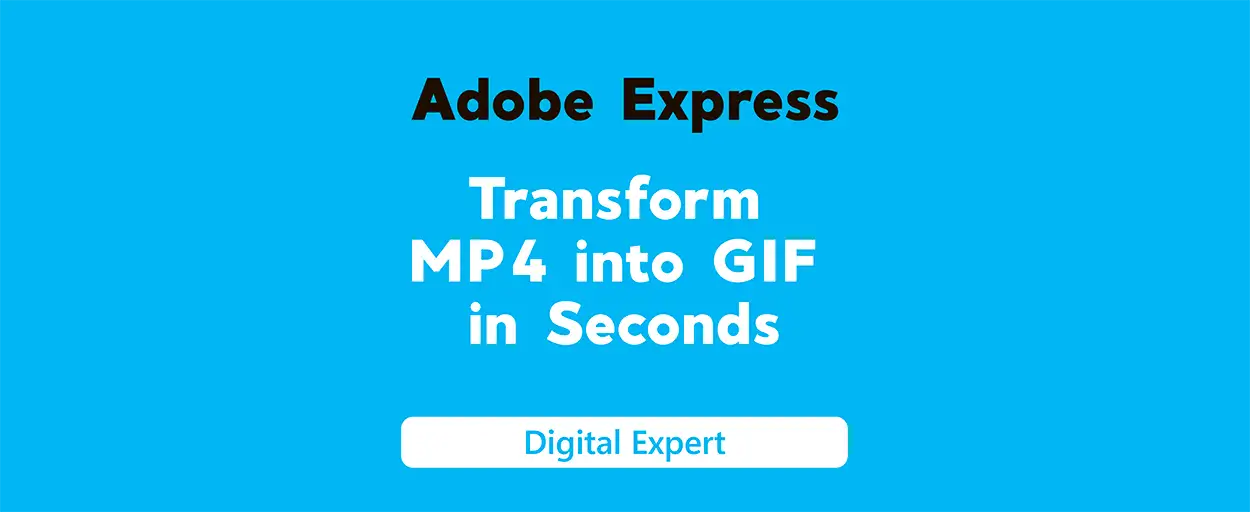Put aside flashcards together with grammar drills. Playing the show "Money Heist" or watching a Korean romantic comedy enables audience members to understand all verbalization on screen while watching without distraction. The core principle that TV show-based language learning is offered as the main focus stands central to the Lingopie review analysis. Through its streaming-style format this language learning application provides interactive subtitles as well as on-the-fly flashcards and AI-powered quizzes to help users achieve natural language understanding rather than concrete memorization.
Since the past two weeks I dedicated my time to exploring the Lingopie catalog while toggling between dual subtitles for shadowing dialogues to evaluate its speech coaching features. The following assessment contains objective feedback regarding performance alongside cost breakdown and assessment of Lingopie's ability to surpass the competition among best language learning applications.
TL;DR: Quick Verdict
⭐ Rating |
⭐⭐⭐⭐☆ (4.4 / 5) |
🎯 Best for |
Binge‑watchers who learn better by ear than by textbook |
💸 Lingopie price |
|
🤔 Is Lingopie worth it? |
If you’ll watch 3–4 shows a week, the annual plan pays off fast. Casual learners may want the 7‑day free trial first. |
✔️ Why you’ll love it |
|
❌ Why you might skip it |
|
Quick takeaway: a budget‑friendly language learning app that turns screen time into study time—strong enough for beginners, flexible enough for B2‑level polishers.
Table of Contents
What is Lingopie?
Lingopie is a language learning app that turns real TV shows into immersive study sessions. The platform shows authentic native-language content from movies, thrilling dramas and documentaries which includes interactive study features during playback sessions.
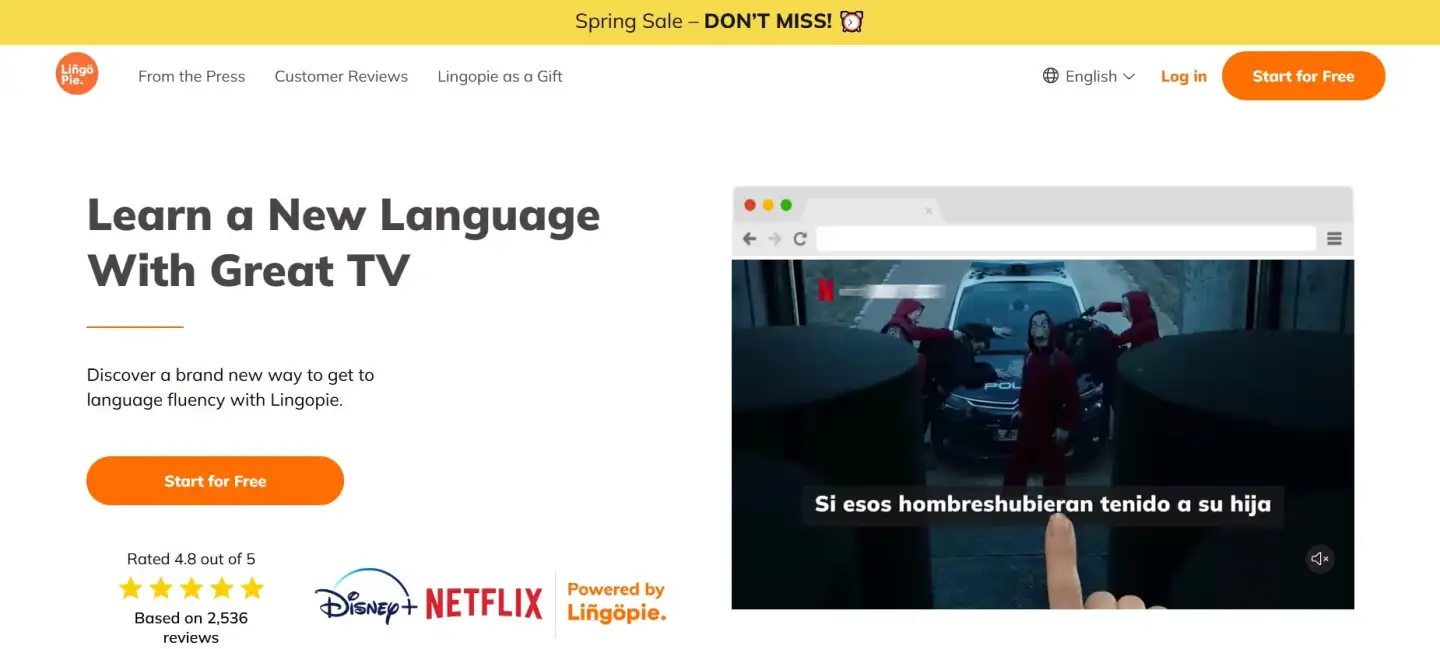
At its core, Lingopie blends language immersion with functionality: clickable interactive subtitles, dual-language playback, and instant vocabulary tools. You receive video pause and instant translation along with automatic flashcard addition after tapping a word within the app interface.
The entertainment component of Lingopie stands apart as people find this structure to be the standout feature. The platform organizes shows by skill levels and keeps subtitle translations precise to the spoken word and automatic assessment tests develop understanding of watched material.
If you’ve been wondering “what is Lingopie exactly?”—think of it as a streaming service where every scene is a lesson, and every episode is study time disguised as fun.
How Does Lingopie Work?
The operating mechanism of Lingopie transforms your existing screen activities into an organized learning system. The application begins by offering a language selection menu from the twelve available options, which includes Spanish, French, Korean and eleven more choices. Once you choose your show along with your desired difficulty level the program becomes accessible.
As the video plays, dual subtitles appear: one in your target language, the other in your native tongue. Every word is clickable. Lingopie stops the video automatically while displaying word translations which then get saved to flashcard decks instantly when users select the terms. That’s the backbone of its interactive subtitles system.
Users can find show content divided by CEFR standards (A1 to C1) to match their study requirements. The built-in player enables multiple functions including sentence looping and slow playback and entire dialogue review. Add to that a Grammar Coach, pronunciation tests, and instant quizzes, and you get a study session without ever opening a textbook.
So how does Lingopie work? The platform extracts natural speech from genuine media sources and adds adaptive learning features on top. Your vocabulary expands automatically through the platform's programs which you utilize unintentionally while learning.
Main Features
Lingopie doesn’t just stream foreign-language content—it builds a learning framework around it. Below are the core features that make it more than just passive watching.
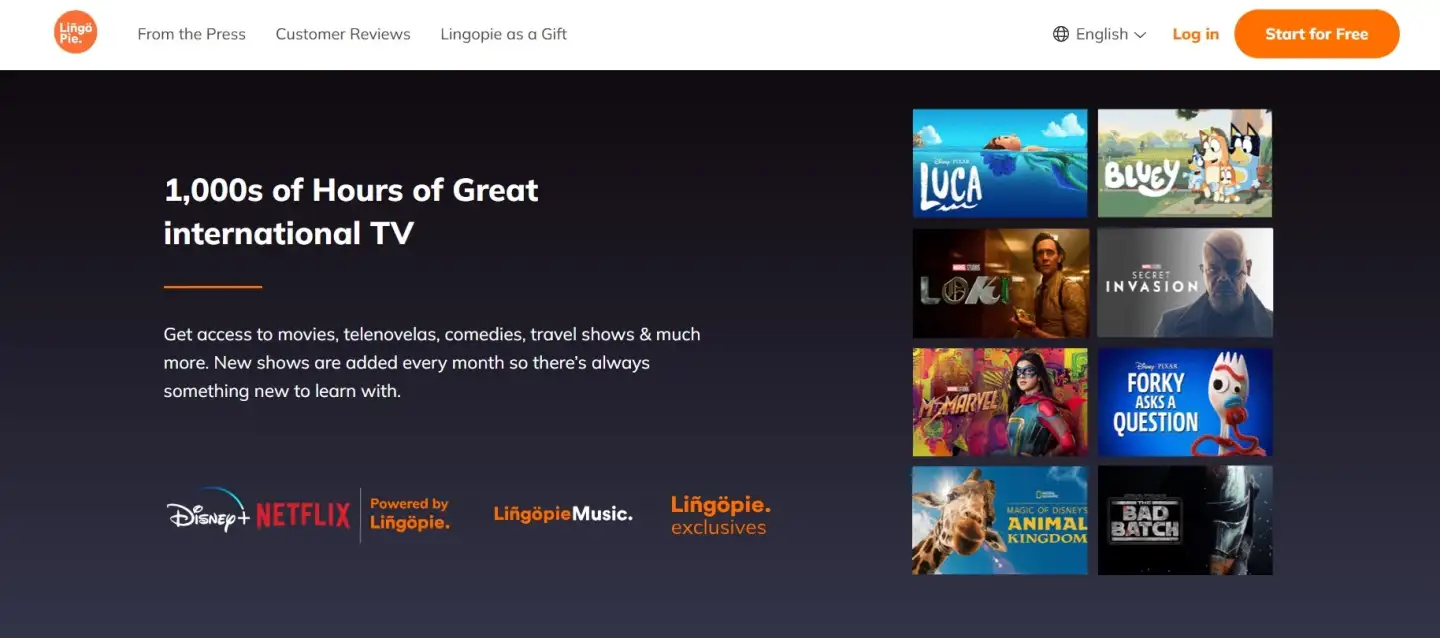
Interactive Subtitles: Each line of dialogue includes clickable interactive subtitles. Tap a word, and the video auto-pauses, revealing its translation, pronunciation, and context. The word is also saved to a flashcard deck for later review. You can switch between translations or turn them off entirely, depending on your learning style.
Dual Subtitles: By default, Lingopie shows dual subtitles: the original language alongside your native language. This visual pairing helps you follow context without losing track of grammar or idioms. You can also toggle either language on or off at any time.
Flashcards and Review Tools: Every word you click is saved automatically. Later, you can review them using spaced repetition decks. Lingopie also offers built-in quizzes and recall exercises tied to the shows you’ve watched—no need to build a study plan from scratch.
Grammar Coach and Explain AI: A recent addition, Explain AI allows you to highlight a sentence and get an instant breakdown: grammar, sentence structure, tense, and nuance. It’s not just translation—it’s explanation. This tool is especially helpful for intermediate learners navigating unfamiliar syntax.
Looping and Playback Control: Struggling with a phrase? Loop it. Want to slow the pace? Drop playback speed to 0.5x. These controls are integrated directly into the player, letting you control how and when to focus on certain lines.
Cross-device Learning: Lingopie works across web, iOS, Android, and most smart TVs. That means you can jump between devices without losing your saved flashcards or watching history. Ideal for switching between desktop deep-dives and casual evening learning on the couch.
These tools come together to create a language learning app that adapts to your pace, interests, and goals—without removing the fun of simply watching a show.
Languages Available
At the time of writing, Lingopie languages span a dozen major tongues—enough to keep even serial polyglots busy. Each catalogue is graded from A1 beginner clips to C1 documentaries, so you can jump in at a comfortable level and climb.
Language |
Approx. hours of video |
CEFR range |
|---|---|---|
Spanish |
1 600 h |
A1–C1 |
French |
1 200 h |
A1–C1 |
German |
800 h |
A1–B2 |
Italian |
650 h |
A1–B2 |
Portuguese (BR) |
600 h |
A1–B2 |
Japanese |
450 h |
A1–B1 |
Korean |
430 h |
A1–B1 |
Hebrew |
300 h |
A1–B1 |
Chinese |
280 h |
A1–B1 |
English |
250 h |
A2–B2 |
Turkish |
220 h |
A1–B1 |
A quick search bar lets you filter by genre, accent, or CEFR band, while personalised recommendations surface fresh episodes once you finish a series.
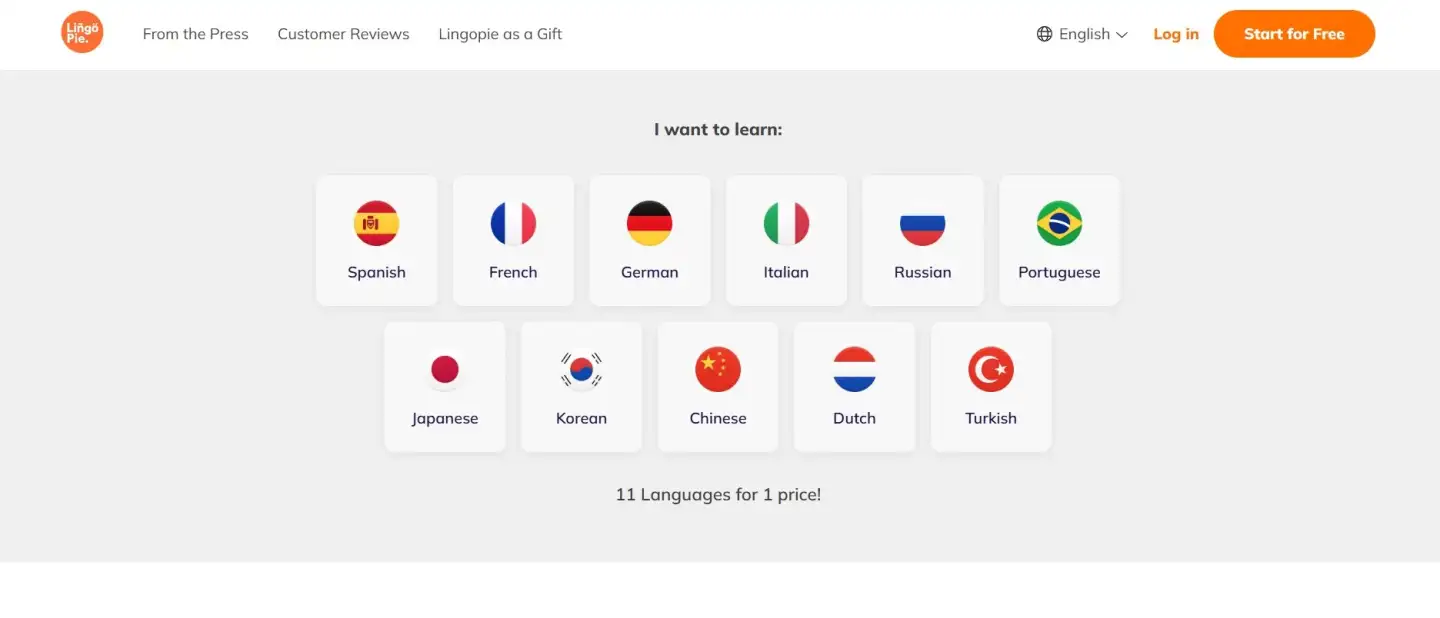
Tip: Smaller libraries (Chinese, Turkish) still add new episodes monthly, so bookmark the content update calendar anchor to track drops. You can find the best meeting scheduler here.
Lingopie Price & Plans
How much does Lingopie cost? The platform keeps its menu straightforward—three paid tiers plus a no‑strings trial. Below is the current Lingopie pricing snapshot for both the U S and the UK.
Plan |
What you pay |
What you get |
Cost per month |
Best for |
|---|---|---|---|---|
Monthly |
$12 / £9.99 |
One screen, all languages |
$12 · £9.99 |
Testing the waters |
Annual |
$67 / £59 |
Four screens, priority support |
$5.60 · £4.92 |
Long‑term study, family use |
Lifetime |
$199 / £169 |
Four screens, updates for life |
One‑off fee |
Committed binge‑learners |
Key Points at a Glance
Is Lingopie free? — Seven‑day full‑access trial. No credit card needed for the first episode of each show.
How much is Lingopie per month? — $12 monthly or roughly £10 if you’re in the UK.
Annual savings: the $67 yearly plan drops your effective rate by more than 50 %, making it the sweet spot for anyone who studies at least twice a week.
How much does Lingopie cost UK? — £59 annually or £169 for lifetime access. VAT is included in the displayed total.
Does Lingopie cost money after the trial? — Yes, you’ll choose one of the paid Lingopie plans above; otherwise, your account reverts to the limited demo mode.
If you’re on the fence about whether Lingopie is worth it, compare the annual fee with a month of private lessons or a single textbook. For many learners, the math works out in Lingopie’s favour—especially when you factor in new shows added every month.
Pros & Cons
✅ Pros |
❌ Cons |
|---|---|
Interactive subtitles turn every tap into an instant flashcard—no break in flow. |
No true offline mode yet; binge‑learning on flights or subways still requires data. |
Real‑world language immersion with native actors, slang, regional accents. |
Smaller catalogues for Turkish and Mandarin trail behind Spanish and French. |
Seamless dual subtitles—toggle either line on the fly for quick comprehension checks. |
Speech‑recognition quizzes lag on older phones and mis‑score some accents. |
Straight‑forward Lingopie pricing; annual plan costs less than a single private lesson per month. |
Interface localisation is mostly English; menus aren’t yet translated for every target language. |
Built‑in spaced‑repetition decks remove the need for third‑party flashcard apps. |
Parental filters are basic, so younger viewers can stumble onto mature shows. |
Cross‑device sync: start on a smart‑TV, continue on mobile without losing progress. |
Support is email‑only; promised live chat hasn’t launched. |
Worth it? If you learn best through stories and dialogue, Lingopie’s advantages outweigh its growing pains—provided you can live without offline viewing for now.
Hands‑on Test: Our 2‑week Challenge
I gave Lingopie fourteen days to prove itself—and logged every minute. My target language was Spanish, CEFR A2. Here’s the raw data:
Total screen time: 11 hours 42 minutes
Episodes finished: 18 (mix of sitcoms and mini‑documentaries)
Words clicked via interactive subtitles: 312
Flashcards mastered (SRS “green” stage): 188
Speaking drills completed: 27
Day 1–3: Settling in
I started with "Los Años Maravillosos Latino", watching with dual subtitles until my ear adjusted. The pause‑and‑translate flow felt natural; vocabulary went straight into decks without manual entry. Within three evenings I could follow jokes with Spanish subs alone—a small but motivating win.
Day 4–7: Building Momentum
Switching to the crime series "Who Killed Sara?" cranked up slang and regional accents. Looping a line three times, shadowing out loud, then toggling subs off became my rhythm. By the end of week one I’d recorded a 78 % recall rate in Lingopie’s built‑in quiz—higher than my usual Anki sessions.
Day 8–12: Testing Conversations
I paired daily viewing with five‑minute speaking drills. The AI coach flagged mis‑pronounced rolled R’s but otherwise passed me at 90 % accuracy. A quick vocabulary building review each morning kept new words sticky.
Day 13–14: Does Lingopie Work?
To answer the burning query “does Lingopie work”, I booked a 30‑minute Google Meet chat. My tutor noted smoother verb agreement and fresher idioms than two weeks prior. Not fluency, but undeniable progress.
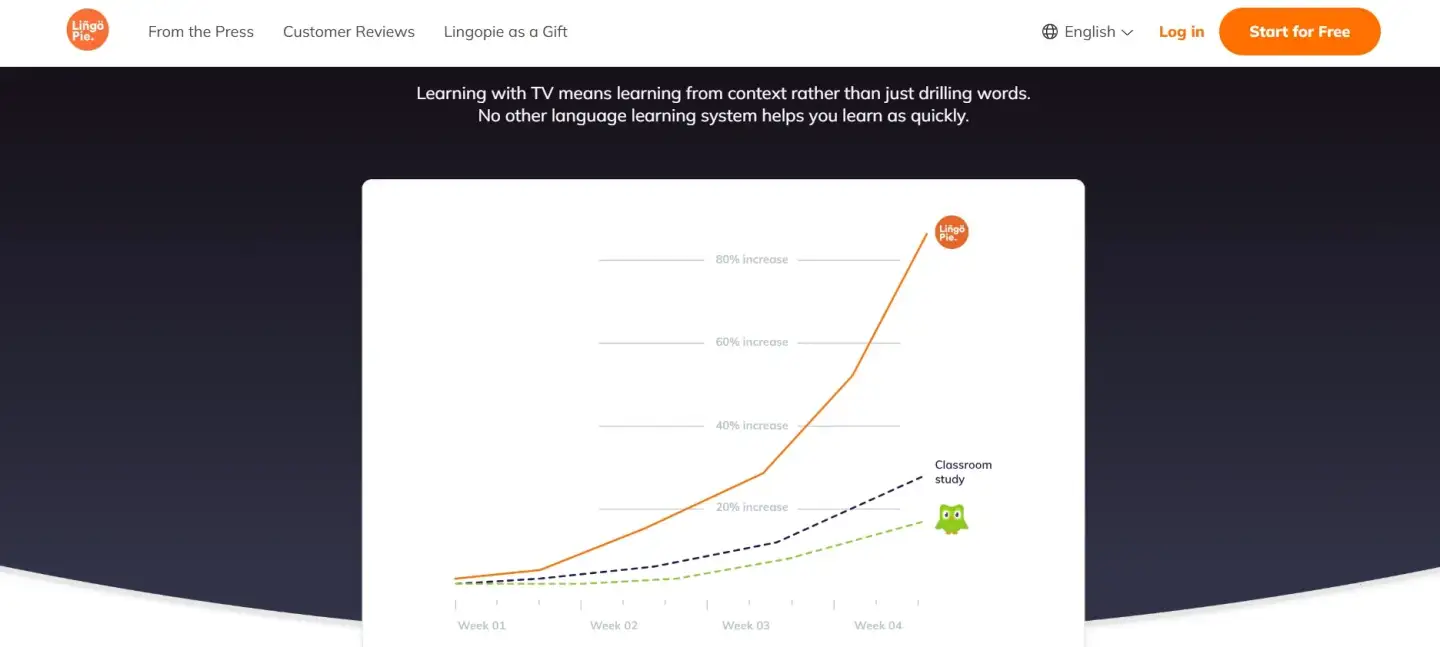
Takeaway: For consistent binge‑watchers, the numbers back up the promise. Lingopie may not replace grammar books, yet for language learning with TV shows it delivers measurable gains—and yes, for me it proved Lingopie is good value on the annual plan.
How to Use Lingopie Effectively
1. Pick the right entry point
Before you hit play, filter the catalogue by CEFR grade—A1 clips for fresh starters, B2 thrillers for veterans. Beginning at a level that still feels comfortable keeps motivation high and reduces early subtitle dependence.
2. Start with dual subtitles, then wean off
Watch the first two episodes with dual subtitles to map sounds to spelling. On episode three switch to target‑language subtitles only; by episode five toggle captions off for the opening five minutes. This staggered reduction forces authentic language immersion without overwhelming you.
3. Tap, pause, shadow
Whenever a phrase trips you up, click the word, let interactive subtitles reveal the meaning, then speak the line aloud twice—once at normal speed, once slowed to 0.75×. The built‑in loop button lets you repeat without fiddling with the timeline.
4. Treat flashcards as a warm‑up, not homework
Your clicked words auto‑populate a flashcard deck. Spend five minutes reviewing them before you watch the next episode, not after. This primes your brain to notice the terms in context, a proven retention booster.
5. Use the Explain AI pane sparingly
Grammar breakdowns are handy, but pausing every sentence kills flow. Limit yourself to three “Explain” clicks per session—enough to clarify thorny structures while preserving binge momentum.
6. Speak into the mic daily
Lingopie’s pronunciation coach scores your accent in real time. Record a tricky sentence at least once per session; aim for a 90 % score before moving on. Small, consistent vocal reps trump marathon speaking drills.
7. Pair shows with a theme goal
Focus week‑by‑week: one week of cooking shows to nail kitchen verbs, one week of sitcoms for casual banter. The thematic grouping accelerates pattern recognition and keeps you from random hopping.
8. Log wins in a progress diary
A simple bullet list—“understood a joke without pausing,” “held 5‑minute chat”—builds momentum and answers the inner skeptic asking “does Lingopie work?”
Follow this eight‑step flow and how to use Lingopie stops being a question; it becomes your nightly habit.
How to Cancel Lingopie?
Cancel step‑by‑step
Sign in on desktop. The mobile app only forwards you to the web portal.
Click the gear icon → Billing.
Scroll to Plan details and hit Cancel membership.
Choose a reason (optional), then confirm.
Look for a “Lingopie subscription cancelled” email—keep it as proof until the next billing date passes.
Refund tip: Annual plans cancelled within the first 14 days are fully refundable; monthly plans run until the end of the current cycle. For edge cases see the subscription FAQ.
Is Lingopie Safe?
Stripe handles payment processing, and every page of the website requires HTTPS, ensuring that card information never comes into contact with Lingopie's own servers. User data, including flashcards, viewing history, and microphone recordings, is stored on secure AWS instances in the US and the EU that are fully GDPR compliant. No third-party advertisements monitor your viewing preferences, and if you decide to permanently leave, you may delete your account (along with all of your saved vocabulary) from the same billing option.
Bottom line: Is Lingopie safe? - Yes, as safe as any mainstream streaming platform, provided you use a unique password and cancel before the renewal date if you decide it isn’t for you.
Final Thoughts: is Lingopie Worth It?
The answer will vary depending on your learning style after two weeks of nighttime binge-learning. Lingopie is worth while if natural dialogue makes your brain light up and you're prepared to click, shadow, and evaluate. For less money than one individual session per month, the app's combination of interactive subtitles, CEFR tracking, and quick flashcards transforms passive viewing into quantifiable progress.

However, those who need offline study or are grammar-first learners may find that the current feature set is lacking. But when evaluated only on its promise—learning a language through TV shows—Lingopie outperforms all of its streaming-based competitors in terms of value for money.
Remember that the platform magnifies your efforts, regardless of whether you sign up for the annual subscription or jump right in with the free trial. The benefits will come if you approach each episode as a teaching opportunity. That makes the membership a wise choice for compulsive show-watchers like me, and is Lingopie worth it? Definitely for my study style.
In the U.S., the monthly plan is $12, the annual is $67, and the lifetime option is $199. UK pricing stands at £9.99/month, £59/year, and £169 for lifetime access.
You can start with a 7‑day free trial. It gives you full access to all shows, features, and review tools without requiring payment upfront.
The monthly plan is £9.99, the annual plan is £59, and the lifetime plan is £169—all inclusive of VAT.
Expect a wide mix—comedies, thrillers, documentaries, cartoons. Spanish and French libraries are the most robust, while Korean, Japanese, and English have solid genre variety.
You watch real TV shows with interactive subtitles and dual subtitles. Tap a word to get its translation, pronunciation, and flashcard.
Yes. Once your trial ends, you’ll need to choose a plan. Without a subscription, access is limited to sample content.
Yes, especially at CEFR A1–A2 levels. The subtitles, grammar hints, and playback controls are tailored to early learners.
Yes. Once your trial ends, you’ll need to choose a plan. Without a subscription, access is limited to sample content.
Absolutely. Cancellation is available via the billing menu on desktop. Refunds apply to annual plans cancelled within 14 days.
Yes. Payments are processed securely, and your learning data is stored in GDPR‑compliant servers.
Monthly, annual, and lifetime—with up to 65% savings on the yearly option.








